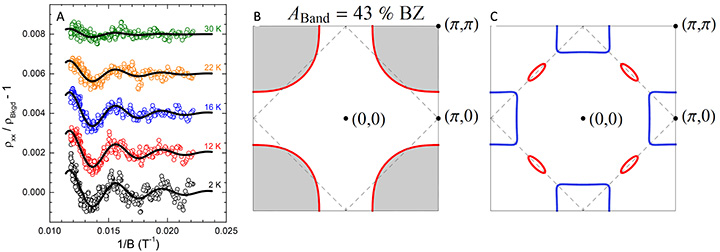Shubnikov-de Haas Quantum Oscillations Reveal a Reconstructed Fermi Surface Near Optimal Doping in a Thin Film of the Cuprate Superconductor Pr1.86Ce0.14CuO4±δ
Understanding the ordering phenomena that compete or coexist with superconductivity in the cuprate superconductors remains an outstanding challenge. Central to this effort is the identification of Fermi surface topology and evolution with doping via studies of magnetic quantum oscillations (QO), led by initial observations of QO in hole-doped YBa2Cu3O6.5 [1]. We reported [2] on the Fermi surface topology and effective mass in the electron-doped cuprate superconductor Pr2–xCexCuO4 (PCCO) with x = 0.14. PCCO thin films have been grown by molecular beam epitaxy onto (001) SrTiO3 substrates and annealed in order to maximize the mean-free path length [3]. We observe Shubnikov-de Haas QO in a PCCO thin film measured under extreme magnetic fields up to 92 T, where magneto-transport data [Fig. 1(A)] show evidence for a small Fermi surface pocket (255 T), a light quasi-particle with effective mass of m* = 0.43 me, allowing direct determination of the orbitally averaged Fermi velocity of vF = 2.4×105 m/s. For comparison, the Hall conductivity at 2 K is 0.9×10–9 Ωm/T, resulting in a charge carrier density per CuO2 plane of 0.66 by assuming a single parabolic band [Fig. 1(B)]. The small Fermi surface pocket indicates a reconstruction [Fig. 1(C)], coupled with a similar observation of Ce-free Pr2CuO4 films [4], suggests that small Fermi surface pockets are a universal feature of cuprate superconductors with square-planar coordinated copper.
- [1] D. LeBoeuf et al., Nature 450, 533 (2007).
- [2] N. P. Breznay, I. M. Hayes, B. J. Ramshaw, R. D. McDonald, Y. Krockenberger, A. Ikeda, H. Irie,
- H. Yamamoto, and J. G. Analytis, Phys. Rev. B 94, 104514 (2016).
- [3] A. Ikeda, H. Irie, H. Yamamoto, and Y. Krockenberger, J. Mater. Res. 31, 3522 (2016).
- [4] N. P. Breznay, R. McDonald, Y. Krockenberger, K. A. Modic, Z. Zhu, I. M. Hayes, N. L. Nair, T. Helm,
- H. Irie, H. Yamamoto, and J. G. Analytis, arXiv:1510.04268 (2015).

|
| Fig. 1. (A) Low-temperature magneto-resistance of a superconducting Pr2-xCexCuO4 thin film measured up to 92 T at temperatures between 2 and 30 K. (B) 2D Fermi surface area [ABand = 43% of Brillouin zone (BZ)] estimated using Hall effect measurements as discussed in the text. (C) 2D Fermi surface area (red pockets) estimated from magnetic quantum oscillations [AQO = 0.97% of Brillouin zone (BZ)]. |